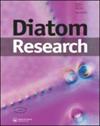在哥斯达黎加高地发现一种未描述的Aulacoseira
IF 1.3
3区 生物学
Q2 MARINE & FRESHWATER BIOLOGY
引用次数: 1
摘要
Aulacoseira属是世界性的,经常在淡水中大量存在。在哥斯达黎加,除了我们自己的探索外,淡水硅藻调查仅限于流动水域。在大约90个湖泊的沉积物样本中,我们遇到了一个未描述的物种,我们在这里建议将其命名为Aulacoseira umanai Haberyan sp.nov。在这个物种中,较大的阀瓣表面通常带有脊和结节(结节);分离棘较短(<2.3 µm),并且没有较长的刺。环纹岩厚、坚硬且非常宽。这一点,再加上它的短茎,将A.umanai与该属的许多其他物种区分开来。乌马奈奥拉科塞拉丰富地存在于超过3450个冰川湖的表层沉积物中 Cerro Chirripó海拔m;它在La Chonta沼泽的冰川时代沉积物中也很丰富(2310 m a.s.l.)。它似乎是从一个类似于a.alpigena的祖先进化而来的;这一事件的地点尚不清楚,但很可能是中美洲地峡的一个高海拔湖泊。本文章由计算机程序翻译,如有差异,请以英文原文为准。
Discovery of an undescribed species of Aulacoseira from highland Costa Rica
The genus Aulacoseira is cosmopolitan and often abundant in fresh waters. In Costa Rica, freshwater diatom surveys have been restricted to flowing waters, aside from our own explorations. Among sediment samples from some 90 lakes we have encountered an undescribed species which we herein propose to name Aulacoseira umanai Haberyan sp. nov. In this species, the face of larger valves often bears ridges and tubercles (knobs); separation spines are short (<2.3 µm) and longer spines are absent. The ringleiste is thick, solid, and very wide. This, in combination with its short collum, distinguishes A. umanai from many other species of the genus. Aulacoseira umanai is abundant in the surficial sediments of multiple glacial lakes that are over 3450 m in elevation on Cerro Chirripó; it is also abundant in glacial-age deposits in La Chonta bog (2310 m a.s.l.). It seems to have evolved from an ancestor that resembled A. alpigena; the locality of this event is unknown but was likely to have been a high-altitude lake in the Central American isthmus.
求助全文
通过发布文献求助,成功后即可免费获取论文全文。
去求助
来源期刊

Diatom Research
生物-海洋与淡水生物学
CiteScore
2.70
自引率
16.70%
发文量
27
审稿时长
>12 weeks
期刊介绍:
Diatom Research is the journal of the International Society for Diatom Research. The journal is published quarterly, in March, June, September and December, and welcomes manuscripts on any aspect of diatom biology.
In addition to full-length papers, short notes and reviews of recent literature are published which need not contain all the sections required for full-length papers; we see these as being necessary to record information which is of interest but which cannot be followed up in detail. Discursive “Opinion” papers are encouraged which would not necessarily follow the normal lay-out. If extremely long papers are to be offered, the author(s) should contact the editors first to discuss any problems. Book reviews, obituaries and meeting reports can be published. All papers will be subject to critical review by the editors and referees, as appropriate to their content. Papers will be accepted in English only.
 求助内容:
求助内容: 应助结果提醒方式:
应助结果提醒方式:


